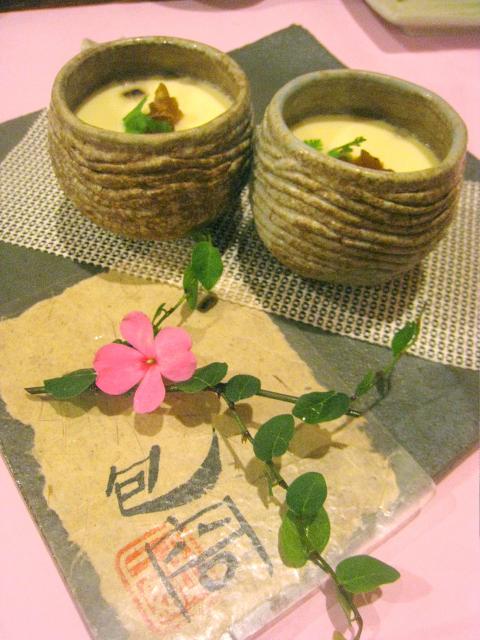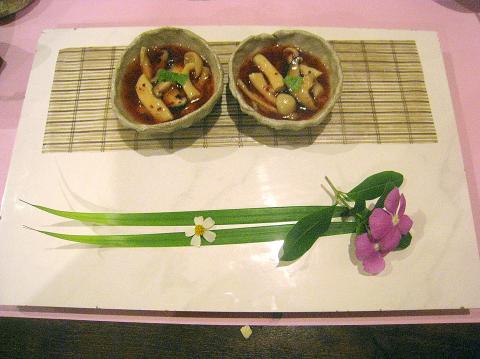Hidden on a back road in Luodong Township (羅東) in Yilan County, Guest City (客人城) is nothing like its English name suggests. Instead of a big, flashy facade and a lengthy menu promising everything land and sea have to offer, the establishment is a traditional, rather conservative farmer’s house and the menu is wholly at the discretion of the proprietor. Set menus weigh in at between NT$400 and NT$500 for a 10-course meal. The menu changes seasonally, with minor variations for product availability. The design of the menu is under the control of Chen Kuo-chang (陳國章), an artist and former veterinary surgeon who has been running this center of artisanal food for over a decade.
The dishes served at Guest City are what Chen feels are right for the moment. As the food arrives, he does a round of the tables in the rustic cotton pajama outfit of a farmer, sans footwear. He is more than happy to go into considerable detail about the food, as many of the materials and condiments are either homegrown, or at least prepared using local ingredients.
The style of the food is modern Taiwanese, and the presentation is designer rustic. All the crockery and some of the utensils are the handmade creations of the proprietor, including both rough terra-cotta ware and some found art (one of the serving platters used was a commercially produced tile that had been slightly embellished). There is much to admire in the presentation. The food was mostly good to excellent over the 10 courses, with a few minor blips, but there was always something to keep it interesting.

Photo: Ian Bartholomew, Taipei Times
Chen preaches a return to old-style culinary values. He makes a wide range of vinegars that are used to dress some of the dishes, produces his own sun-dried radish (untouched by any chemicals) and even makes his own sausages and cured meats. The portions are small, focusing attention on the individual ingredients.
A tiny bowl of crisp, raw pumpkin marinated in homemade vinegar had remarkably vibrant flavors. A small mound of seasonal vegetables, blanched and lightly dressed, was extremely delicate. A lightly stewed bowl of three types of mushroom forced one to contemplate the relationship between texture and flavor.
A small dish of asparagus tips was spoilt by a squeeze of what was clearly commercially produced mayonnaise. The vegetable itself was soft with a slight crispness, but the provenience of the mayo spoiled the purity of the overall presentation. This was just a tiny misstep — a thoughtless following of a popular Taiwanese culinary practice.

Photo: Ian Bartholomew, Taipei Times
A selection of cold meats, served on a taro leaf, was interesting. The quality of the meat was good and a side of lightly pickled cucumber set it off nicely. A very fine steamed egg and a dark soup of pork and dried radish each showed considerable character. Most of the dishes are served in small bowls, and bulk is provided by steamed rice mixed with lard, another rustic staple that is coming back into fashion.
The care and commitment that has gone into the creation of the dining experience is very much apparent at Guest City, but for some, the food might be a trifle bland. Care and attention is needed to appreciate the refinement of the preparation, but sometimes the flavors are simply not big enough to make an impression. All of this can make the dining experience at Guest City ever so slightly anemic, especially for those who favor rich flavors and hearty portions. For the health conscious, or for those who want to taste the terroir of Yilan through its natural produce and its traditional culinary practices, Guest City will provide a most interesting experience.

That US assistance was a model for Taiwan’s spectacular development success was early recognized by policymakers and analysts. In a report to the US Congress for the fiscal year 1962, former President John F. Kennedy noted Taiwan’s “rapid economic growth,” was “producing a substantial net gain in living.” Kennedy had a stake in Taiwan’s achievements and the US’ official development assistance (ODA) in general: In September 1961, his entreaty to make the 1960s a “decade of development,” and an accompanying proposal for dedicated legislation to this end, had been formalized by congressional passage of the Foreign Assistance Act. Two

Despite the intense sunshine, we were hardly breaking a sweat as we cruised along the flat, dedicated bike lane, well protected from the heat by a canopy of trees. The electric assist on the bikes likely made a difference, too. Far removed from the bustle and noise of the Taichung traffic, we admired the serene rural scenery, making our way over rivers, alongside rice paddies and through pear orchards. Our route for the day covered two bike paths that connect in Fengyuan District (豐原) and are best done together. The Hou-Feng Bike Path (后豐鐵馬道) runs southward from Houli District (后里) while the

March 31 to April 6 On May 13, 1950, National Taiwan University Hospital otolaryngologist Su You-peng (蘇友鵬) was summoned to the director’s office. He thought someone had complained about him practicing the violin at night, but when he entered the room, he knew something was terribly wrong. He saw several burly men who appeared to be government secret agents, and three other resident doctors: internist Hsu Chiang (許強), dermatologist Hu Pao-chen (胡寶珍) and ophthalmologist Hu Hsin-lin (胡鑫麟). They were handcuffed, herded onto two jeeps and taken to the Secrecy Bureau (保密局) for questioning. Su was still in his doctor’s robes at

Mirror mirror on the wall, what’s the fairest Disney live-action remake of them all? Wait, mirror. Hold on a second. Maybe choosing from the likes of Alice in Wonderland (2010), Mulan (2020) and The Lion King (2019) isn’t such a good idea. Mirror, on second thought, what’s on Netflix? Even the most devoted fans would have to acknowledge that these have not been the most illustrious illustrations of Disney magic. At their best (Pete’s Dragon? Cinderella?) they breathe life into old classics that could use a little updating. At their worst, well, blue Will Smith. Given the rapacious rate of remakes in modern